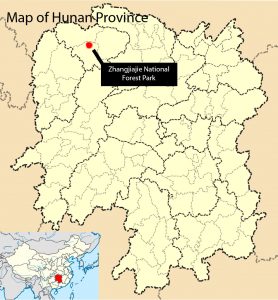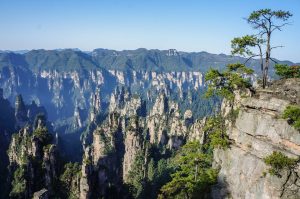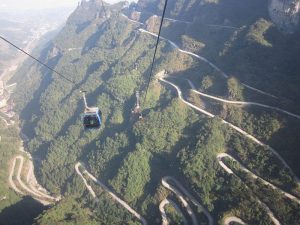Zhangjiajie National Forest Park (ZNFP) was the first national forest park accepted by the International Union for Conservation of Nature (IUCN) in China in 1982. ZNFP covers 4,810 ha of land located in the northwestern region of Hunan Province near Zhangjiajie City (Wang et al. 2012).

Untapped Beauty (Before 1978)
Prior to 1978, this area of China was a forest farm, meaning the forest was a major area of planting and logging. After staff members of the Forestry Department of Hunan province realized and documented the unique beauty of Zhangjiajie Forest, visitors began coming to the forest farm for sight-seeing purposes. At this point in time, the area was still very rural and undeveloped (Zhong, Deng, & Xiang, 2007).

The Rise of Tourism (1982-1988)
The local provincial government along with the Ministry of Forestry quickly learned that they could make money from the farm. By 1980, the local county government began investing in roads and electrical lines to facilitate tourism in the area, and in 1982 the Ministry of Forestry suggested the park be set aside as a National Forest Park (Chen & Yakama, 2013).
In order to satisfy a growing number of tourists, within a six year period the government invested close to $2 million in hotels, a major road connecting the new national forest to a nearby city, and a section of a national railway system (Chen & Yakama, 2013).
Watch a short video tour of the park here:
When Commercialism Takes Over (1989-1999)
From 1989 to 1999, the park faced a rapid increase in the number of visitors accompanied by rapid development, modernization, and physical transformation of the park and its surrounding areas. The number of visitors jumped from 381,500 in 1989 to 1,187,400 in 1999 (Zhong, Deng, & Xiang, 2007).

Leading this rise in tourism was not only the increased national publicity about the park, but also in 1992 the United Nations Educational, Scientific and Cultural Organization (UNESCO) named the forest park along with 2 nearby nature reserves a World Natural Heritage site. This area is also now known as the Wulingyuan Scenic and HistoricInterest Area (WSHIA) (Zhong, Deng, & Xiang, 2007).
The creation of WSHIA vastly increased the number outside funders interested in investing in Zhangjiajie National Forest Park. The surrounding towns also experienced high levels of urbanization as a result of the park. Nearby villages and city municipalities began relying on tourism as a major driver of economic development. Both the government and outside investors played a major role in encouraging the development of the park (Wang et al., 2012).

So What Now? (2000 and beyond)
Between 2000-2005, the park averaged over a million tourists annually. Although development has slowed, the Chinese government continues to encourage and advertise tourism to Zhangjiajie National Forest Park. Some of the most noteworthy features of ZNFP are the 150-900 feet high sand stone pillars, the cable cars, and a glass bridge (Chen & Yakama, 2013).
Below is a video of the glass bridge:
Common tourists activities include sight-seeing, hiking and bus tours. This area also contains large amounts rare and endangered wildlife and vegetation, making the safe-keeping of the land of utmost importance to the environment (Zhong, Deng, & Xiang, 2007).
Click on the following links to learn more about Environmental Consequences, Issues of Power and Privilege, and International Action in Zhangjiajie National Forest Park.
Citations:
[Aj+]. (2015, Oct 01). Terrifying glass bridge in China’s Zhangjiajie National Forest [Video File]. Retrieved December 6, 2016 from https://www.youtube.com/watch?v=Hyv39DxQlFM&feature=youtu.be
Boris, G. (Photographer). (2015). Tianmen mountain cave Zhangjiajie China [Photograph]. Flickr. Retrieved from: https://www.flickr.com/photos/gameoflight/26842481536
[Btosold]. (Photographer). (2012). National Park Zhangjiajie [Photograph]. Pixabay. Retrieved December 6, 2016 from https://pixabay.com/p-222363/?no_redirect
Chen, B., & Nakama, Y. (2013). Thirty years of forest tourism in china. Journal of Forest Research, 18(4), 285-292. doi: 10.1007/s10310-012-0365-y
Galindo, C. A. (2014). Zhangjiajie [Photograph]. Flickr. Retrieved from: https://www.flickr.com/photos/cadampol/17405916911
[Huangdan2060]. (Photographer). (2010). Tian Menschan Mountain [Photograph]. Wikimedia. Retrieved from: https://commons.wikimedia.org/wiki/File:Tian_Menshan_Mountain_2.jpg
[Lonely Planet]. (2015, Nov 25). Zhangjiajie National Forest Park – China – Lonely Planet travel video [Video File]. Retrieved December 6, 2016 from https://www.youtube.com/watch?v=TmQgunRix4A&feature=youtu.be
[Philg88]. (2014). Location map of Hunan. [Image]. Wikipedia. Retrieved from: https://en.wikipedia.org/wiki/Tianmen_Mountain#/media/File:Location_map_China_Hunan_EN.svg
Wang, G., Innes, J. L., Wu, S.Vy’., Krzyzanowski, J., Yin, Y., Dai, S., . . . Liu, S. (2012). National park development in China: Conservation or commercialization. Ambio, 41 (3), 247 -261. doi: 10.1007/s13280-011-0194-9
Zhong, L., Dang, J., & Ziang, B. (2007). Tourism development and the tourism area life-cycle model: A case study of Zhangjiajie National Forest Park, china. Tourism Management. 1-16. doi:10.1016/j.tourman.2007.10.002
